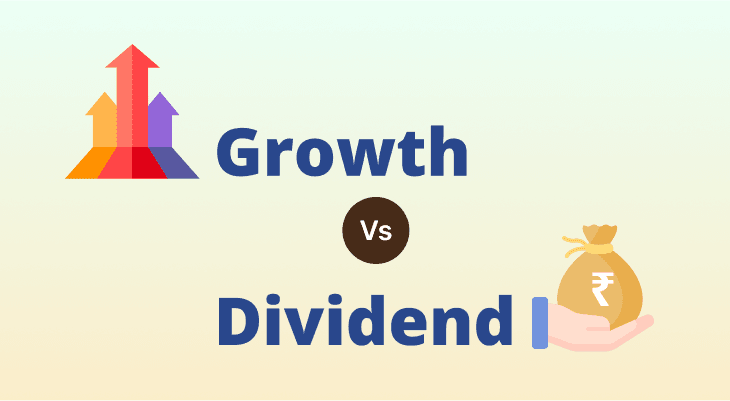
A Comparison Between Growth and Dividend Reinvestment Options
In the constantly evolving landscape of personal finance, the decision between growth and dividend reinvestment is a common dilemma for investors. The assurance of a steady income stream versus the security of long-term wealth creation – “growth or dividend reinvestment, which is better?” – is a question that frequently occurs in the minds of investors. It gets further complicated due to the seeming similarities between the two concepts.
Our comprehensive guide will unravel the finer points while providing insights into the key considerations, compounding effects, and associated risk profiles, empowering you to make a choice aligned with your financial aspirations. Whether you seek steady income or aim for a corpus for your future, this exploration will equip you with the knowledge to navigate the dynamic world of investment options.
Understanding the Growth Option
In mutual fund investments, the growth option is often preferred by those seeking capital appreciation. This option allows you to witness the growth of your principal amount over time without the regular payouts that come with dividends. With a focus on long-term wealth accumulation, the growth option reinvests profits back into the scheme, compounding the overall returns.
Let’s assume you invest ₹ 10,000 in a mutual fund under the growth option. Over time, as the fund's portfolio grows, your initial investment keeps getting larger without any regular payouts. Let's say the value increases to ₹ 15,000. Here's the catch – you won't see that additional ₹ 5,000 in your hands until you decide to redeem your units. The growth option, therefore, focuses on accumulating wealth over time, letting your money work behind the scenes.
Understanding the Dividend Reinvestment Option
On the other hand, the erstwhile dividend plan – now known as the Income Distribution cum Capital Withdrawal (IDCW) plan caters to investors who prefer a consistent stream of income. In this, you get regular payouts in your account acting as a source of regular fixed income to meet your general expenses. While these plans are easy to find, a lesser common variant of the IDCW plan is the Dividend Reinvestment Option. Instead of receiving dividends in cash, this option automatically reinvests the dividends paid out by the companies that form a part of the fund back into the scheme. This process can enhance the number of units held by an investor, potentially leading to increased future payouts.
Imagine you invest ₹ 10,000 in a mutual fund, and periodically, the fund declares dividends. Instead of receiving these dividends in cash, the dividend reinvestment option takes that ₹ 2,000 dividend (assuming a 20% dividend declared on your initial investment) and reinvests it back into the scheme. This reinvestment doesn't add to your pocket immediately, but it buys more units of the fund, amplifying your holdings. So, while you don't get cash in hand, your investment grows through an increased number of units, potentially leading to higher future payouts.
It is important to note that in the dividend reinvestment option, while your holdings size (number of units held in the end) increases, the Net Asset Values (NAV) price goes down about adjustment after the dividend is announced. In the same example as above, let’s assume the NAV was ₹ 10. So, your ₹ 10,000 investment bought you 1000 units of the fund. After a while, the NAV increases to ₹ 20 per unit with a dividend payout of ₹ 2 per unit (20% of NAV), the dividend amount would be ₹ 2000 (1,000 units × ₹ 2). In the dividend reinvestment option, the NAV adjusts downward to ₹ 18 (₹ 20 - ₹ 2).
The ₹ 2,000 dividend is reinvested, fetching you an additional 111.11 units (₹ 2,000 ÷ ₹ 18). The total units now amount to 1,111.11, resulting in a revised investment value of ₹ 19,998 (1,111.11 units × ₹18).
In the growth option, where NAV remains at ₹ 20 per unit, the investment value stays at ₹ 20,000 (₹ 20 × 1,000 units). The number of units remains constant at 1,000 in the growth option scenario.
How Are Both Options Taxed?
It is clearly visible from the aforementioned example that the eventual gains in both options are rather similar. So, then why do the two options exist? In the growth vs dividend reinvestment rebate, the growth option takes the lead when it comes to taxation. This is because in the dividend reinvestment plan, your overall investment value is reduced compared to the Growth Plan due to the impact of taxes on dividends and the application of TDS. Here's why.
All dividends from Mutual Fund schemes are subject to taxation based on the investor's income tax slab. Reinvesting dividends in the same mutual fund scheme does not provide any tax relief. Even though the dividends are not received in your bank account, you are liable to pay tax on them as the income tax department treats reinvested dividends as part of your income. For instance, if you fall into the 20% tax bracket, you will be taxed at a rate of 20% on the dividends declared in the IDCW Reinvestment Plan for a financial year, further diminishing your Mutual Fund returns.
Additionally, a 10% TDS is levied on dividends exceeding ₹ 5,000 in Mutual Fund schemes. In the given example, the reinvested amount is reduced due to TDS on mutual fund dividends, leading to a lower final value of investments. The IDCW Reinvestment Plan returns will only match those of the Growth Plan if the declared dividend is below ₹ 5,000, and your total taxable income is less than ₹ 5 lakh annually. In such cases, no TDS is applicable, and you won't incur any tax on your dividends, resulting in the reinvested amount in the dividend reinvestment plan being the same as the Growth Plan.
Dividend Reinvestment or Growth Option: Which is Better?
Ultimately, the choice between growth vs dividend reinvestment depends on individual preferences, financial goals, and risk tolerance. You must carefully evaluate your unique circumstances, considering factors such as income needs, tax implications, and the desired level of involvement in managing their investment portfolio. If long-term wealth creation and tax efficiency are your key criteria, the growth option presents an attractive proposition. Else, the dividend reinvestment option can be considered as well.
An Income Tax Calculator helps you estimate how much tax you need to pay based on your income, deductions, and exemptions. Use our Income Tax Calculator to understand your tax liability better and plan smarter to save more.
FAQ
Which option is better – growth or dividend reinvestment?
The gross value of your holding in both options is usually comparable. However, growth options score in the aspect of tax efficiency, making the net value more than dividend reinvestment options in most cases.
Can I switch between growth and dividend reinvestment options?
While this is theoretically possible, the dividend reinvestment option is not very commonplace. You will need to check if your fund scheme offers this option and allows for switching between the two.
How does compounding work in the growth option?
In the growth option, profits are reinvested, compounding over time. This compounding effect enhances the overall returns on the initial investment.
Can I choose between cash dividends and reinvestment in the dividend reinvestment option?
No, the dividend reinvestment option automatically reinvests dividends back into the scheme, increasing the number of units held while lowering the NAV. To receive cash dividends you will need to opt for an Income Distribution cum Capital Withdrawal (IDCW) plan.
How are taxes calculated in the growth option during redemption?
In the growth option, capital gains tax is applicable during redemption, calculated based on the profit made on the initial investment and the holding period of the units.
Are there any lock-in periods for growth and dividend reinvestment options?
Most mutual funds usually do not have specific lock-in periods for these options, offering liquidity and the flexibility to redeem units when needed. However, you will need to check the offer scheme to understand the applicable lock-in period and exit load, if any.
Can I receive regular payouts in the growth option?
No, the growth option does not provide regular payouts. Profits are reinvested, and returns are realised upon redemption, making it more suitable for long-term wealth accumulation.


